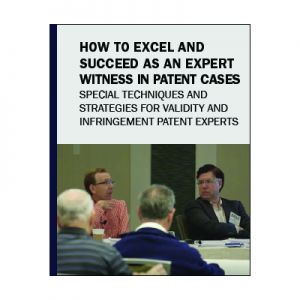Excerpted from SEAK’s Course: How to Excel as an Expert Witness in Patent Cases: Special Techniques
So technology tutorials can be incredibly useful, as I’ve said before. What they do…you’re educating the judge, you’re educating the judge’s clerks, if he’s got a technology advisor, you’re educating the technology advisor on the technology. And while these are intended to be neutral…not adversarial, and there shouldn’t be any “advocacy”…you typically can put together a technology tutorial that skews things in the way that you want to. So if you’re on the defendant’s side, you’re going to tell the technology in a way that talks about all this great prior art that’s out there and how all this stuff was already known. And then, “Oh, and then this invention came along because the patent office didn’t really look at that prior art.” So you’d have a technology tutorial that’s kind of, like, geared that way. If you’re working on the plaintiff’s side, you’re gonna gear it a different way, which is, “You know, there was this industry and people were really struggling to solve this problem, and this inventor came along and boom, he came up with this great idea and we got this invention. And here, let me tell you about this great invention.” So you kinda see how the technology tutorial, while being generically a tutorial of the technology, can be useful to start to shape the case in the way that you want it to be shaped. So ways you can do technology tutorials. You can present it with the briefs. So typically, especially now, what we’ve been seeing are you submit a DVD with, like, a PowerPoint presentation that you would otherwise present, and the expert is narrating it…goes along and narrates it. Or we could have the attorney narrate it, but the experts have assisted us in putting it together. That’s kind of typical. You submit your brief and you say, “Here’s the DVD. Please take a look at that.” Others would be days before a Markman. On December 12th of this year, I have a technology tutorial down in Texas, and then two days later, we have the Markman. So we’ll have the technology tutorial. It’s still undecided how exactly we’re gonna do it, but there’s a chance we could have an expert come talk about the technology. And then, two days later, we do the Markman hearing. Others you do it right that day of the Markman hearing. It starts to eat into how much time the judge is really gonna give you that day for Markman, and so I kinda prefer either submitting with the briefs or maybe a few days earlier. But that’s how it’s going. So and you can see some judges, like Judge Stark, he’s a Chief Judge of the District of Delaware, which is a very popular patent jurisdiction now because that’s where companies are incorporated. He actually requires parties to provide a tutorial on the technology with their opening brief. So there he has them submit DVDs or a joint DVD. Trying to get the parties to agree on what the technology tutorial is, that’s like herding cats. So typically you’re gonna do separate DVDs. I can’t think of one where we’ve had a joint DVD, but it could happen. Yeah, and as you can see here, what Judge Stark’s saying is pretty common, which is that the tutorial should focus on the technology at issue and should not be used for argument. So they all say that. We all say, “Okay, we agree with that,” and then we have tutorials that are, you know, straight about the technology, but in a way that you really believe. So here’s an example. I’m gonna go through a couple, just to show it high-level. This is just, I mean, what we use if we have graphics people that work with us hand-in-hand, and they’ll work…

